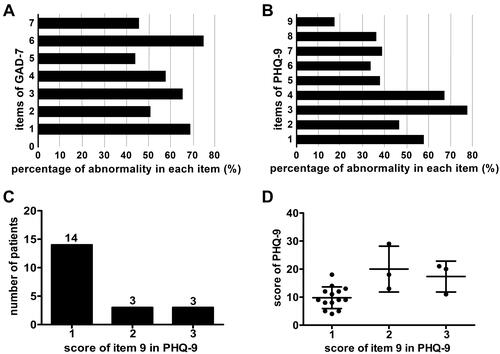Figures & data
Table 1 Anxiety and Depression Evaluated by Different Self-Rating Scales
Table 2 Sociodemographic Characteristics of Patients with Mental Diseases Assessed by GAD-7 and PHQ-9
Table 3 Clinical Manifestations of Patients
Figure 1 Abnormality in each item of GAD-7 and PHQ-9. (A) The percentage of abnormality of each item in GAD-7. The items were as follows: 1. Feeling nervous, anxious or on edge? 2. Not being able to stop or control worrying? 3. Worrying too much about different things? 4. Trouble relaxing? 5. Being so restless that it is hard to sit still? 6. Becoming easily annoyed or irritable? 7. Feeling afraid as if something awful might happen? (B) The percentage of abnormality in each item of PHQ-9. The items were as follows: 1. Little interest or pleasure in doing things? 2. Feeling down, depressed, or hopeless? 3. Trouble falling or staying asleep, or sleeping too much? 4. Feeling tired or having little energy? 5. Poor appetite or overeating? 6. Feeling bad about yourself or that you are a failure or have let yourself or your family down? 7. Trouble concentrating on things, such as reading the newspaper or watching television? 8. Moving or speaking so slowly that other people could have noticed? Or the opposite being so fidgety or restless that you have been moving around a lot more than usual? 9. Thoughts that you would be better off dead, or of hurting yourself in some way? (C) Number of patients with item 9 score which was greater than 0. (D) Total scores of PHQ-9 in different item 9 scores.

